
Strapazierfähige Schließfachschränke für Klassenzimmer der frühen Kindheit
Unsere für Vorschulen und Kindertagesstätten konzipierten Schließfachschränke sind aus hochwertigen, kindersicheren Materialien gefertigt, um Haltbarkeit und Sicherheit zu gewährleisten. Perfekt für die Aufbewahrung von Rucksäcken, Mänteln und Zubehör. Diese Aufbewahrungslösungen fördern die Organisation und verbessern gleichzeitig die Lernumgebung. Es sind anpassbare Optionen erhältlich, die sich nahtlos in Ihr Klassenraumlayout einfügen.
Our Versatile Range of Locker Cubbies
Our locker cubbies collection offers various sizes, colors, and styles to suit any classroom setup, from single-tier to multi-tier configurations. Each product combines functionality, safety, and durability, ensuring a clutter-free and organized space for young learners. Customization options are also available to perfectly match your educational vision.

Garderobenschrank Lagerung

Klassenzimmer-Garderobe

2-teiliger Garderobenschrank mit Bank

Schmaler Garderobenschrank

Schließfach für Kleinkinder

Bank Garderobenschrank mit Spiegel

Doppelwannen-Garderobe

Breites Kinderschließfach

Stapel- und Verriegelungsschrank
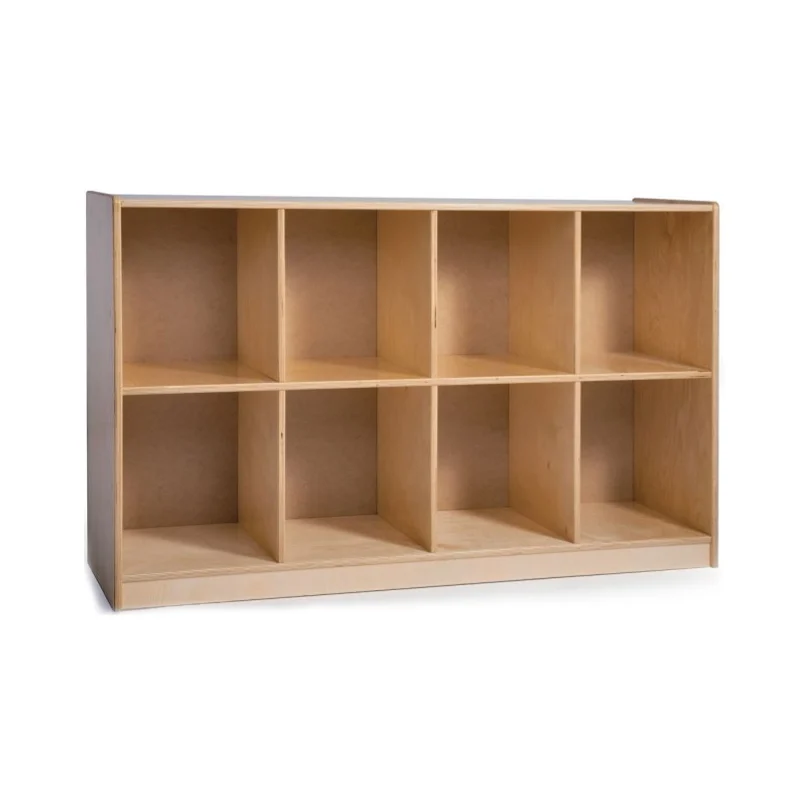
Rucksack Vorschule Cubbies

Wandgarderobe

Wandmontage Garderobenleiste
Professioneller Hersteller von Kita-Möbeln: Mit Qualität Vertrauen schaffen
Winning Kidz verfügt über mehr als 20 Jahre Erfahrung in der Bildungsbranche und stellt sicher, dass jedes von uns entworfene Schließfach nicht nur den Industriestandards entspricht, sondern diese übertrifft. Unsere langjährige Erfahrung in der Gestaltung von Bildungsumgebungen macht uns zu einem zuverlässigen Partner auf Ihrer Bildungsreise.
Sicherheit und Qualität stehen bei allen unseren Produkten an erster Stelle. Unsere Schließfachschränke werden aus den hochwertigsten Materialien hergestellt und entsprechen strengen Sicherheitsstandards, um die Sicherheit der Kinder zu gewährleisten und Erziehern und Eltern ein gutes Gefühl zu geben. Jedes Produkt wird umfangreichen Tests unterzogen, um unsere Qualitätsverpflichtung zu erfüllen.
Da wir wissen, dass jeder Bildungsraum einzigartig ist, bieten wir einen persönlichen Service, um unsere Schließfachschränke an Ihre speziellen Bedürfnisse anzupassen. Von Größenvariationen bis hin zur Farbauswahl arbeitet unser engagiertes Team eng mit Ihnen zusammen, um funktionale, ästhetische Aufbewahrungslösungen zu schaffen, die Ihren Raum ergänzen und die organisatorische Effizienz verbessern.
Materials for Locker Cubbies
Choosing the right materials for Locker Cubbies is crucial for durability, safety, and ease of maintenance. The right material helps create a functional, organized, and safe space for children while also contributing to the overall look and feel of the environment. Whether you prefer the warmth of wood or the practicality of plastic, each material offers specific advantages for preschool use.
-
Solid Wood Description: Solid wood provides a sturdy and durable structure, making it ideal for long-term use. The natural grain and color of wood give each Locker Cubby a unique character, adding warmth to the environment. Solid wood is eco-friendly, offering a stable storage solution to help children organize their personal items effectively.
-
Sperrholz Description: Plywood consists of multiple layers of wood veneer, cross-laminated for superior strength and durability. It is an economical material, providing excellent load-bearing capacity. Plywood is commonly treated for fire and water resistance, making it a safe and long-lasting option for educational environments.
-
Corkboard Description: Corkboard is a soft material made from the bark of cork oak trees. It is known for its natural ability to absorb sound, making it a good choice for environments that require noise reduction. Corkboard is also eco-friendly and provides a soft, tactile surface that is gentle for children to interact with.
-
Medium Density Fiberboard (MDF) Description: MDF is known for its excellent stability and uniformity. It has a smooth surface, which is easy to work with and can be customized with various finishes. MDF Locker Cubbies are perfect for modern educational settings due to their aesthetic flexibility and increased resistance to moisture when properly coated.
-
Metal Frame Description: Locker Cubbies with metal frames offer superior load-bearing capacity and increased durability. The metal framework provides structural stability, making the cubbies more resistant to wear and tear. Metal surfaces are often treated with anti-rust coatings to maintain both appearance and functionality over time.
-
HDPE Description: High-Density Polyethylene (HDPE) is a durable, water-resistant, and impact-resistant plastic material, often used in outdoor settings. Plastic Locker Cubbies are lightweight, easy to clean, and highly resistant to moisture. With UV protection, they are ideal for environments where cleanliness and durability are a top priority.
Essential Role of Locker Cubbies in Early Childhood Education
Locker cubbies are essential to any preschool or daycare setting, offering more than just a place for children to store their belongings. These furniture pieces support both the organizational needs of the classroom and the developmental growth of young learners. Providing each child with a personal space helps instill responsibility, fosters independence, and contributes to a tidy, secure, and well-managed learning environment.
Personal Storage
Each child has a designated cubby for storing their clothes, backpacks, lunchboxes, and other personal items. This encourages responsibility and teaches children the importance of keeping their belongings organized.
Classroom Organization
By providing a structured storage solution, locker cubbies help maintain an orderly classroom. This contributes to a more organized and efficient learning space, allowing for fewer distractions and more focus on learning.
Encouraging Independence
Locker cubbies are designed to be child-friendly, allowing children to access and manage their own items with minimal assistance. This promotes autonomy and builds confidence in young learners as they perform tasks independently.
Safety and Security
Lockers not only keep personal items safe but also reduce the risk of misplaced or lost belongings. A well-organized storage system helps prevent unnecessary confusion and ensures that each child’s items are easily identifiable.
Promoting a Sense of Belonging
Having a dedicated cubby fosters a sense of ownership and belonging in children. It provides them with their own space, which can have a positive impact on their emotional development and self-esteem.
Enhanced Classroom Management
With designated storage areas for each child, teachers can efficiently manage and monitor belongings, ensuring that the classroom remains clutter-free and conducive to learning.
Factors to Consider When Choosing Locker Cubbies for Your Classroom
Choosing the right locker cubbies for your classroom is a crucial decision in creating an organized, functional, and child-friendly learning environment. The right cubbies not only offer convenient storage for children’s personal belongings but also contribute to the overall atmosphere and management of the classroom. There are several key factors to consider to ensure you select the best locker cubbies for your educational space.
-
1. Size and Capacity Consider the size of the cubbies and whether they can accommodate the children's personal items. Look for cubbies that are spacious enough to fit backpacks, coats, lunch boxes, and other personal belongings while being appropriately sized for young children to access easily.
-
2. Safety Features Safety is paramount when choosing locker cubbies. Ensure that the design includes rounded edges, non-toxic finishes, and secure fastenings to prevent injuries. Additionally, consider cubbies with ventilation or open designs to improve air circulation and avoid the buildup of germs.
-
3. Durability and Materials Choose materials that are durable enough to withstand the wear and tear typical in a classroom. High-quality wood, laminate, or sturdy plastic are popular choices that offer long-lasting use. Consider whether the material is easy to clean, as hygiene is especially important in an early childhood setting.
-
4. Accessibility for Children The height and layout of the locker cubbies should be child-friendly. Ensure the cubbies are low enough for children to easily reach their items without assistance. Some cubbies may feature adjustable shelving, which allows for customization as the children grow or as the classroom’s needs change.
-
5.Storage Organization Depending on the size of your classroom and the number of children, you may need cubbies with additional compartments or hooks for hanging coats, hats, and bags. Some cubbies also come with extra features like drawers or trays for organizing smaller items like shoes or toys.
-
6. Aesthetic Appeal Locker cubbies can enhance the overall atmosphere of the classroom. Choose a design that complements your classroom’s theme, whether it’s colorful and playful or more neutral and simple. An appealing design helps create a welcoming and engaging environment for young learners.
-
7. Ease of Maintenance Classroom furniture needs to be easy to maintain, and locker cubbies are no exception. Consider how easy it will be to wipe down, clean, and maintain the cubbies. Materials that resist stains or scuff marks are ideal for high-traffic areas like classrooms.
-
8. Budget and Cost Efficiency Finally, balance quality with cost. While it’s important to invest in sturdy, high-quality cubbies, there are many affordable options that still meet your classroom’s needs. Be sure to choose a product that fits within your budget while offering durability and functionality.
Safety Guidelines for Preschool Locker Cubbies
Safety is the top priority when selecting and using preschool locker cubbies. Ensuring your little learners have a secure, organized space to store their belongings is essential to promoting a safe learning environment. To help you achieve this, we’ve outlined some key safety guidelines for installing and maintaining preschool locker cubbies.
Non-Toxic Materials: All materials and finishes must meet international safety standards, ensuring they are free from harmful substances. The products should be certified with CE, CPC, and other relevant certifications to comply with global safety standards.
Smooth Edges and Corners: Children at this age are naturally curious and constantly moving, so sharp corners or edges on lockers can pose a risk of injury. Ensure all cubbies have rounded corners or protective edge bumpers to minimize the risk of cuts, bruises, or other accidents.
Sturdy Construction Design: Plastic preschool bookcases are best suited for lighter materials and may not be able to support heavy books or resources as effectively as wooden shelves.
Child-Friendly Height: Preschool locker cubbies should be the appropriate size and height for young children. They should be within reach so that the children can easily access their items independently. Too high Lockers may cause children to climb, increasing the risk of falling.
Ventilated Locker Cubbies: To maintain hygiene and prevent unpleasant odors, choose cubbies with proper ventilation. Ventilated locker cubbies allow air to circulate, helping to reduce the buildup of moisture or bacteria.
- Regular Inspection and Maintenance: Once your preschool locker cubbies are installed, regularly inspect them for wear and tear. Look for loose parts, cracked surfaces, or broken latches that could become a safety hazard. Proper maintenance ensures the lockers continue to function safely and efficiently.
Size of Locker Cubbies
| Type of Locker Cubbies | Height | Width per Compartment | Depth |
|---|---|---|---|
| Freestanding Locker Cubbies | 36" (91 cm) to 72" (183 cm) | 12" (30.5 cm) to 18" (45.7 cm) | 12" (30.5 cm) to 15" (38 cm) |
| Corner Locker Cubbies | 36" (91 cm) to 48" (122 cm) | 12" (30.5 cm) to 18" (45.7 cm) | 12" (30.5 cm) to 18" (45.7 cm) |
| Rolling Locker Cubbies | 36" (91 cm) to 48" (122 cm) | 12" (30.5 cm) to 18" (45.7 cm) | 12" (30.5 cm) to 15" (38 cm) |
| Open Shelving Locker Cubbies | 36" (91 cm) to 48" (122 cm) | 12" (30.5 cm) to 15" (38 cm) | 12" (30.5 cm) to 16" (40.6 cm) |
| Locking Locker Cubbies | 36" (91 cm) to 72" (183 cm) | 12" (30.5 cm) to 15" (38 cm) | 12" (30.5 cm) to 16" (40.6 cm) |
| Bench-style Locker Cubbies | 18" (45.7 cm) to 24" (61 cm) | 36" (91 cm) to 48" (122 cm) | 12" (30.5 cm) to 18" (45.7 cm) |
Different Types of Preschool Locker Cubbies

Freestanding Locker Cubbies

Corner Locker Cubbies
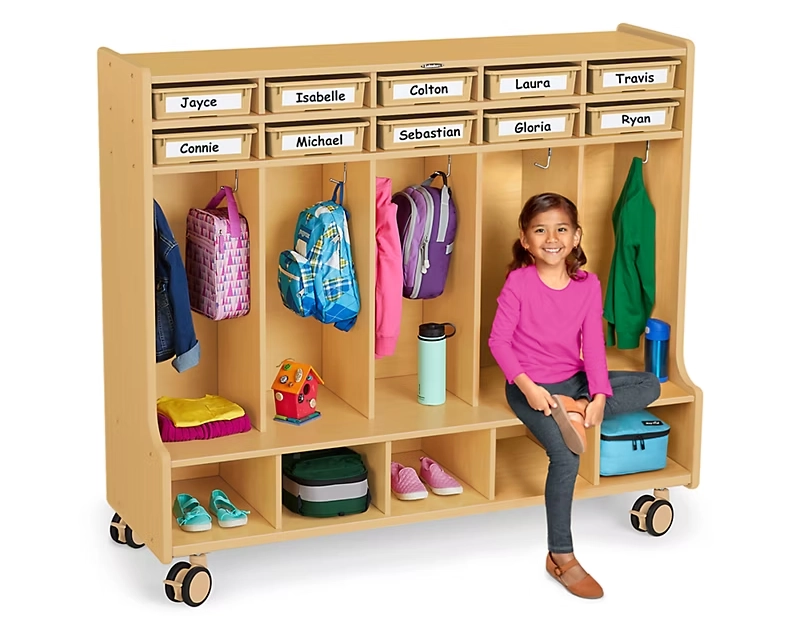
Rolling Locker Cubbies
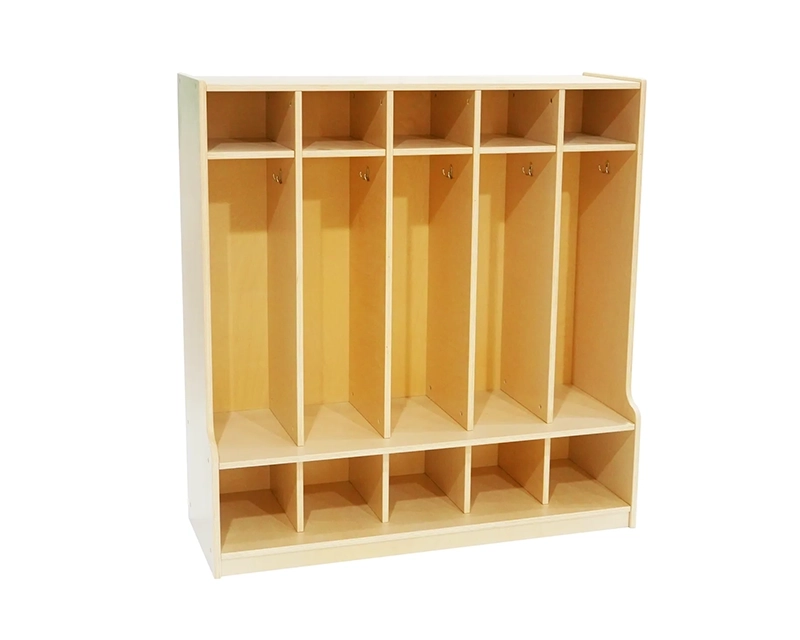
Open Shelving Locker Cubbies
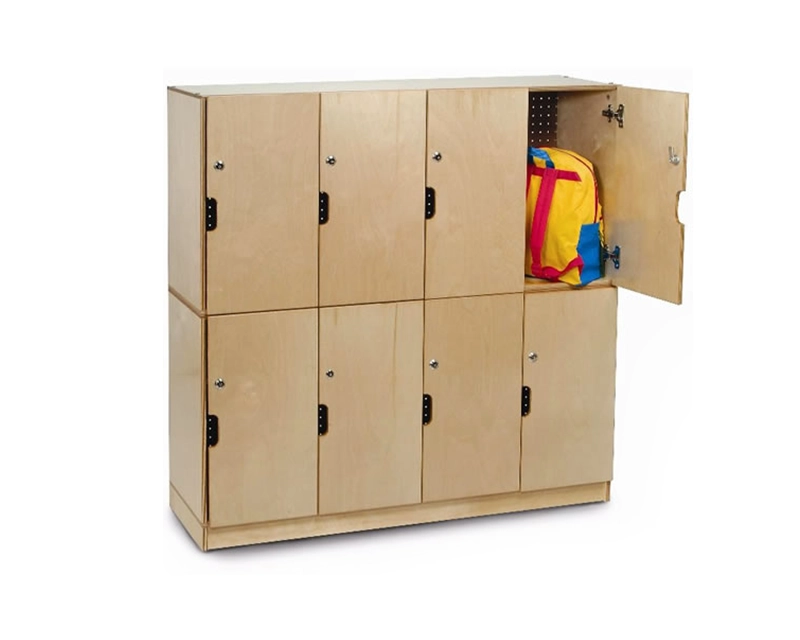
Locking Locker Cubbies
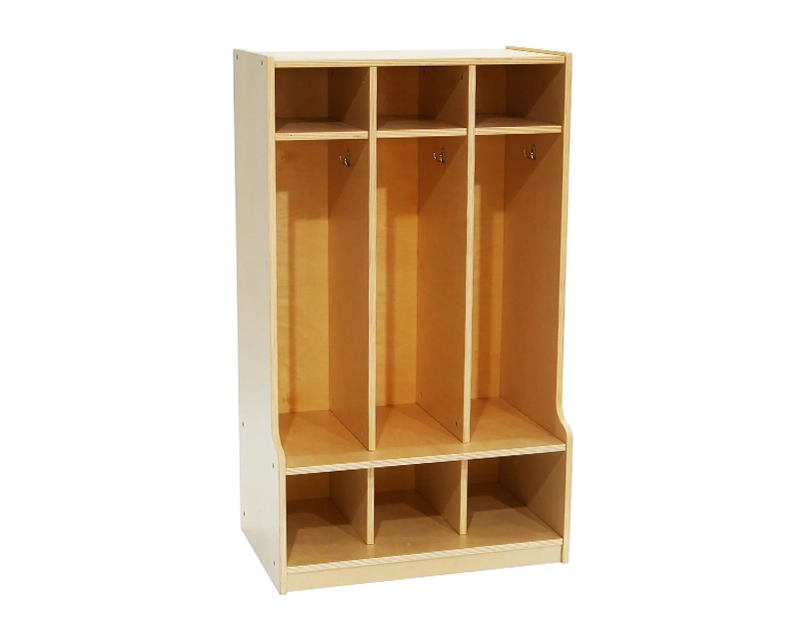
Bench-style Locker Cubbies
Customizable Features for Preschool Locker Cubbies
Preschool lockers can be tailored to fit your classroom's needs and children's developmental stages. Here are the key customizable features:
Size and Configuration: Preschool lockers come in various sizes and configurations to fit different spaces and needs. You can choose from single, double, or triple-tier lockers or even custom multi-compartment designs. The adjustable height and width options allow you to tailor the lockers to your classroomclassroom’smaking efficient use of space while providing ample storage for children’children’sgs.
Material Flexibility: Material flexibility is essential for creating durable and safe lockers. Depending on your durability and aesthetic preferences, choose from a variety of materials, including eco-friendly wood, sturdy MDF, or high-density plastic. These materials ensure that the lockers withstand daily use while being easy to maintain and clean, making them ideal for preschool environments.
Color Options: Add a touch of vibrancy to your classroom with a wide range of color options for your preschool lockers. Whether you want to match your classroom theme or choose colors that engage children, the available color choices include bright primary colors, soft pastels, and custom finishes. The right color can enhance the learning environment and make the space feel welcoming and energetic.
Personalized Name Tags: Personalized name tags help children quickly identify their lockers and encourage independence.Custom name tags, photos, or colorful labels were added to each cubby. This personalization helps young children organize their belongings and fosters a sense of ownership and responsibility as they take care of their designated space.
Shelving and Compartments: Customize the lockers’ interiors with adjustable shelves and compartments to suit the storage needs of different items. You can modify the locker’s layout if you need extra space for backpacks, shoes, or jackets. Adjustable shelving gives flexibility, while specialized compartments allow for neat organization, keeping children accessible and organized.
- Interactive Elements: Make your lockers more engaging with interactive elements like chalkboard or whiteboard surfaces. These interactive features encourage creativity and help children develop fine motor skills as they draw, write, or leave messages for each other. The added fun of interactive lockers can also turn storage time into an opportunity for learning and imaginative play.
FAQ
Können Schließfachschränke gestapelt werden?
Ja, viele Schließfachschränke sind stapelbar und ermöglichen so eine modulare Lagerung. Dies ist besonders nützlich, wenn der Platz begrenzt ist und Sie die vertikale Lagerung maximieren müssen. Achten Sie nur darauf, dass die Schränke sicher gestapelt sind, um mögliche Sicherheitsprobleme zu vermeiden.
Wie hoch ist die Tragfähigkeit von Schrankfächern?
Die Tragfähigkeit von Schließfachschränken ist je nach Material und Konstruktion unterschiedlich. In der Regel können Schränke aus schwerem Metall oder Holz mehr Gewicht tragen, während Schränke aus Kunststoff eine geringere Tragfähigkeit haben können. Prüfen Sie immer die Angaben des Herstellers, um sicherzustellen, dass die Schränke für den vorgesehenen Verwendungszweck geeignet sind.
Für welche Altersgruppe sind die Schließfachschränke geeignet?
Schließfachschränke können für verschiedene Altersgruppen konzipiert werden. Für kleine Kinder, wie z. B. Vorschulkinder, sind die Fächer in der Regel niedriger als der Boden, um den Zugang zu erleichtern. Für ältere Kinder oder Erwachsene können die Schränke höher sein und mehr Stauraum bieten, um größere Gegenstände unterzubringen.
Wie reinige ich Schließfächer?
Die meisten Schließfachschränke sind aus haltbaren, leicht zu reinigenden Materialien gefertigt. Wischen Sie die Oberflächen einfach mit warmem Wasser und einer milden Reinigungslösung ab. Verwenden Sie keine scheuernden Reinigungsmittel, die die Oberfläche zerkratzen könnten. Bei hartnäckigeren Flecken kann eine Bürste mit weichen Borsten verwendet werden, um die Oberfläche sanft abzuschrubben.
Können Schließfachschränke im Freien verwendet werden?
Einige Schließfachschränke sind für die Verwendung im Freien konzipiert, insbesondere für die Aufbewahrung von Sportgeräten oder Outdoor-Kleidung. Diese Schränke für den Außenbereich sind in der Regel aus witterungsbeständigen Materialien wie wasserfesten und rostfreien Metallen gefertigt und können mit Belüftungssystemen ausgestattet sein, um Feuchtigkeitsansammlungen zu verhindern.
Welche Faktoren sollte ich bei der Auswahl von Schrankfächern berücksichtigen?
Bei der Auswahl von Schließfachschränken sollten Sie die Größe des Raums, die Haltbarkeit des Materials, Sicherheitsmerkmale (wie abgerundete Kanten), die Belüftung für nasse Gegenstände und die Anzahl der benötigten Fächer berücksichtigen. Es ist auch wichtig, sich Gedanken über die Anordnung zu machen, um den Fluss des Raums und die Zugänglichkeit für Kinder zu maximieren.
Warum sollten Kinder Schließfächer benutzen?
Schließfachschränke sind ein großartiges Hilfsmittel zur Förderung von Organisation und Unabhängigkeit bei Kindern. Sie bieten einen eigenen Raum für persönliche Gegenstände, was dazu beiträgt, Unordnung zu vermeiden, und den Kindern beibringt, Verantwortung für ihre eigenen Gegenstände in einer gemeinsamen Umgebung zu übernehmen.
Was ist die beste Anordnung für Schließfächer in einem Klassenzimmer für Vorschulkinder?
In Vorschulklassen sollten die Schränke an einem leicht zugänglichen Ort aufgestellt werden, in der Regel in der Nähe der Tür. Niedrige Fächer sind ideal, damit die Kinder selbständig auf ihre Gegenstände zugreifen können. Ziehen Sie reihen- oder L-förmige Konfigurationen in Betracht und achten Sie darauf, dass genügend Platz für eine reibungslose Bewegung im Raum vorhanden ist.



